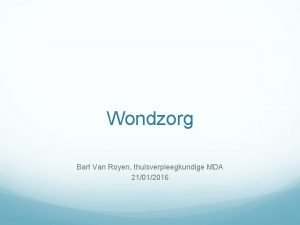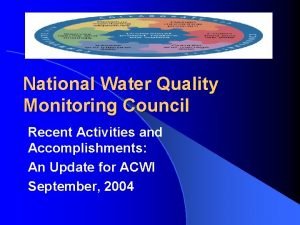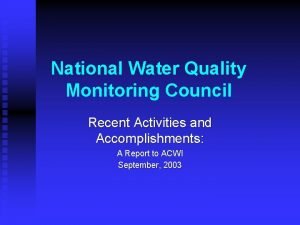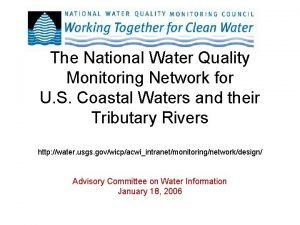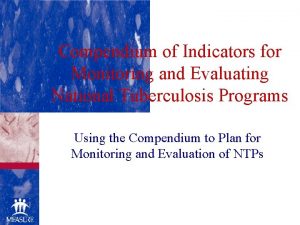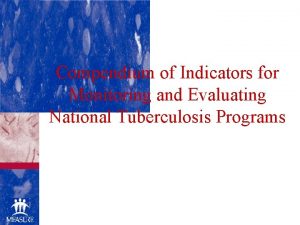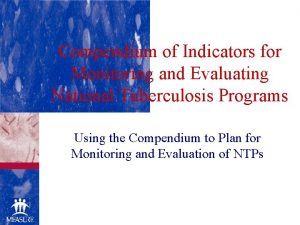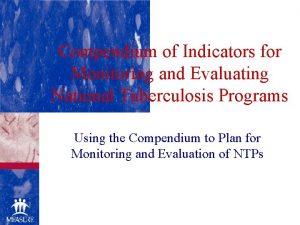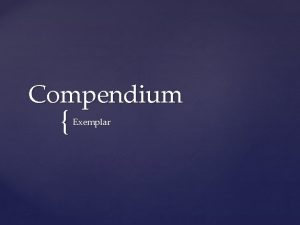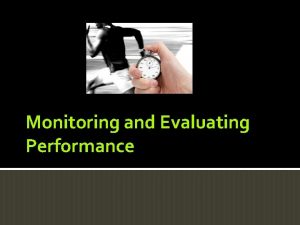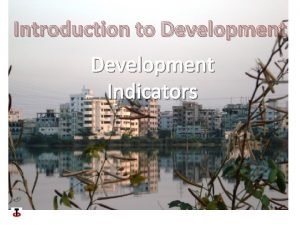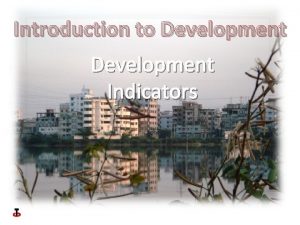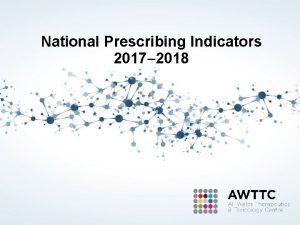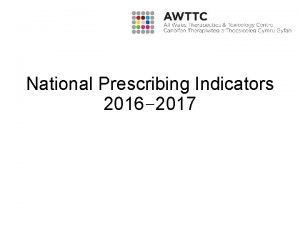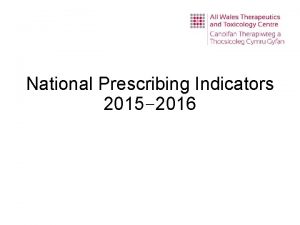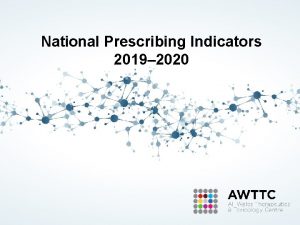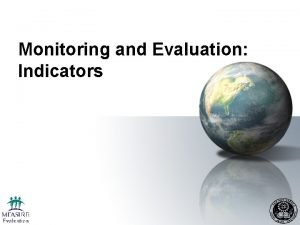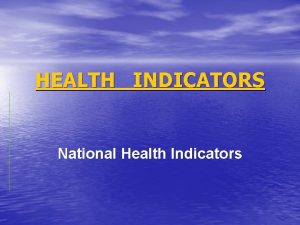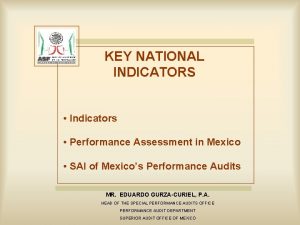Compendium of Indicators for Monitoring and Evaluating National




















- Slides: 20

Compendium of Indicators for Monitoring and Evaluating National Tuberculosis Programs

What is the Compendium? A comprehensive and standardized collection of the most widely used and recommended indicators for monitoring and evaluation of National TB Programs.

Who is it for? • NTP managers, data managers, regional and district officers • NGO program managers/data managers involved in TB programming • Evaluation specialists • Health-system planners (HMIS, etc. ) Ø Anyone with responsibility for collecting, processing, analyzing, and presenting data on tuberculosis programs.

Specific Objectives • Standardize M&E terminology across indicators and programs • Encourage consistent use of indicators to monitor and evaluate programs • Provide guidance for the development of comprehensive evaluation plans • Serve as a resource for the different components of the monitoring and evaluation process

Why a new TB M&E Guide? (1) • Patient follow-up/case management using WHO standardized forms • Need for program data to guide M&E • Small number of indicators focusing on outcomes of DOTS implementation • Project-specific monitoring forms • Periodic assessment visits at facility level

Why a new TB M&E Guide? (2) New Global Initiatives • Global Fund for AIDS, TB, and Malaria • STOP TB Partnership • Increased USAID involvement • TB/HIV initiatives • DOTS Plus

M&E Framework for TB programs INPUT PROCESS OUTPUT OUTCOME IMPACT Policy environment Management Diagnostic services Case detection Prevalence of TB infection Human and Financial Resources Infrastructure Training Drug management Laboratories Communication Advocacy Treatment success Treatment services Prevalence of TB disease Improved knowledge, attitudes, and practices TB morbidity TB mortality Reduced stigma p 7, Compendium of Indicators for Monitoring and Evaluating National Tuberculosis Programs USAID, MEASURE, CDC, WHO, IUATLD, KNCV, MSH. WHO/HTM/TB/2004. 344, August 2004

Expansion of M&E activities • Framework links inputs, processes to outputs, outcomes, impact • Standardized indicators for global use • Program-based to complement case management • Program-specific indicators for different settings, types of programs

International M&E Guidance • Provide most useful indicators for monitoring and evaluating TB control programs • Encourage use of standardized definitions of indicators and terminology across programs, countries and donor agencies • Provide measures of process and output linked to program activities • Promote process and impact evaluation of TB control programs

M&E Framework for TB Programs INPUT PROCESS OUTPUT OUTCOME IMPACT Policy environment Management Diagnostic services Case detection Prevalence of TB infection Human and Financial Resources Training Drug management Infrastructure Laboratories Communication Advocacy Treatment success Treatment services Prevalence of TB disease Improved knowledge, attitudes, and practices TB morbidity TB mortality Reduced stigma p 7, Compendium of Indicators for Monitoring and Evaluating National Tuberculosis Programs USAID, MEASURE, CDC, WHO, IUATLD, KNCV, MSH. WHO/HTM/TB/2004. 344, August 2004

Compendium Development • Step 1: Assessment of existing M&E systems within national TB programs and MOH • Step 2: Create an international TB M&E working group to develop and review indicators • Step 3: Field test indicators in selected countries • Step 4: Build capacity in M&E to collect, disseminate, and use information

Step 1: Assessment of current M&E systems • Field visits to examine M&E systems: data collection forms, reporting, supervision, data use • South Africa, Russia, Honduras, Philippines • Met with NTPs, USAID missions, WHO, CDC, local implementing partners • Review of literature on TB indicators

Results from assessment visits • Substantial amount of data collected at facility level that is not reported • Weakness in reporting mechanisms for facility level data • Few indicators on political commitment, IEC activities, drug supply and TB/HIV • Lack of data from private sector physicians

Step 2: Creation of an international working group • Similar goals to develop more informative indicators on program implementation • Bring expertise from a wide variety of sources: Stop TB, WHO, UNION, KNCV, CDC, USAID, World Bank, MSH, MEASURE/Evaluation

Results of TB M&E Working Group • Indicators for DOTS: measure key aspects of the TB epidemic in a country and the programmatic response • Based on WHO recommendations and collected through existing systems • External and Expert review

Step 3: Field testing • Peru, Kazakhstan, Haiti, and Thailand • Revision of indicators based on field-testing results Step 4: Building capacity • Egypt (March), Mexico (this workshop), Cambodia (June), Sub-Saharan Africa (June) • Technical assistance

Indicators (1) • Global indicators (5) – Case detection – Treatment success – DOTS coverage – HIV seroprevalence among TB cases – Surveillance of MDR-TB • Routinely reported program outcomes – Case detection (6) – Smear conversion – Treatment outcome

Indicators (3) • Process indicators to measure DOTS implementation under expanded framework: – Political commitment (12) • NTP annual work plan and budget – Diagnosis (7) • Existence of comprehensive laboratory network – Case management, including DOT (2) • Proportion of patients with correct prescription – Drug management (8) • Existence of a quality assurance system for drug management

Indicators (3) • Process indicators to measure DOTS implementation under expanded framework: – Recording & reporting (2) • Accuracy of reports sent to NTP – Supervision (2) • Existence of supervision guidelines – Human resources development (3) • Proportion of health centers with at least one professional trained in the DOTS strategy – Health systems (1) • Equitable distribution of DOTS

Conclusion • Introduction to the Compendium – overview and background Next – • How to use the Compendium
 Compendium of sanitation systems and technologies
Compendium of sanitation systems and technologies Higher pe monitoring and evaluating
Higher pe monitoring and evaluating Distraneurin compendium
Distraneurin compendium Invasive species compendium
Invasive species compendium Pregabalion
Pregabalion Cabi compendium
Cabi compendium Cavilon creme compendium
Cavilon creme compendium Time model
Time model Ddi compendium
Ddi compendium The first stage of god’s revelation was
The first stage of god’s revelation was Physiological indicators examples
Physiological indicators examples National water quality monitoring conference
National water quality monitoring conference National water quality monitoring council
National water quality monitoring council Nwqmc conference
Nwqmc conference National water quality monitoring conference
National water quality monitoring conference National unification and the national state
National unification and the national state Fspos vägledning för kontinuitetshantering
Fspos vägledning för kontinuitetshantering Typiska drag för en novell
Typiska drag för en novell Tack för att ni lyssnade bild
Tack för att ni lyssnade bild Returpilarna
Returpilarna Varför kallas perioden 1918-1939 för mellankrigstiden?
Varför kallas perioden 1918-1939 för mellankrigstiden?







